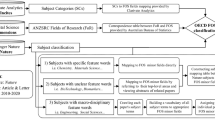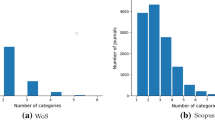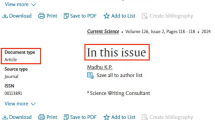Abstract
A serious shortcoming of bibliometric studies based on theSocial Sciences Citation Index is the lack of a universally applicable subject classification scheme as individual papers are concerned. Moreover, the selective coverage of more than thousand scientific journals per annum proved to be an insuperable obstacle in the delimitation of social science subject areas. Subject classification of papers on the basis of assigning journals to subject categories (like those found in the various supplements of ISI databases) works well in case of fully covered and highly specialised journals in the social sciences, too, but fails for multidisciplinary and selectively covered journals. This study presents the results of an item-by-item subject classification approach, where assignment is based on the analysis of the subject categories of reference literature.
This analysis extends the results of an earlier study by the authors on the possibility of delimiting subfields in the hard and life sciences based on reference analysis. The assignment proved also reliable for a considerable share of literature in the social sciences. Due to the peculiarities of the database this share is lower in the SSCI than that in the SCI. Although an iterated application of the procedure is expected to increase the number of classifiable publications, it is suggested that in the sociated sciences the method should be used in combination with other means of subject assignment.
Similar content being viewed by others
References
Braam, R.R., H.F. Moed, A.F.J. Van Raan, (1991), Mapping of science by combined co-citation and co-word analysis 1.JASIS, 42 (4) 233–251.
de Bruin, R.E., H.F. Moed (1993), Delimitation of scientific subfields using cognitive words from corporate addresses in scientific publications,Scientometrics, 26 (1) 65–80.
Glänzel, W., U. Schoepflin (1999), A bibliometric study of reference literature in the sciences and social sciences,Information Processing and Management, 35, 31–44.
Glänzel, W., A. Schubert, H.-J. Czerwon, (1999) An item-by-item subject classification of papers published in multidisciplinary and general journals using reference analysis,Scientometrics, 44, 427–439.
Narin, F. (1976),Evaluative Bibliometrics: The Use of Publication and Citation Analysis in the Evaluation of Scientific Activity, Computer Horizons, Inc., Washington, D.C.
Schubert, A., W. Glänzel, T. Braun, (1989) Scientometric Datafiles. A comprehensive set of indicators on 2649 journals and 96 countries in all major fields and subfields 1981–1985.Scientometrics, 16 (5–6) 3–478
Small, H. (1997), Update of science mapping: creating large document spaces,Scientometrics, 38 (2) 275–293.
Small, H. (1998), A general framework for creating large-scale maps of science in two or three dimensions: The Sci Viz system,Scientometrics, 41 (1–2) 125–134.
Author information
Authors and Affiliations
Rights and permissions
About this article
Cite this article
Glänzel, W., Schubert, A., Schoepflin, U. et al. An item-by-item subject classification of papers published in journals covered by the SSCI database using reference analysis. Scientometrics 46, 431–441 (1999). https://doi.org/10.1007/BF02459602
Received:
Issue Date:
DOI: https://doi.org/10.1007/BF02459602




